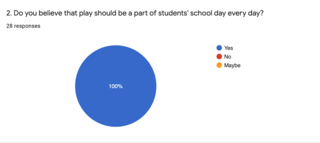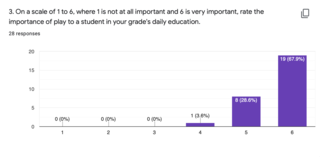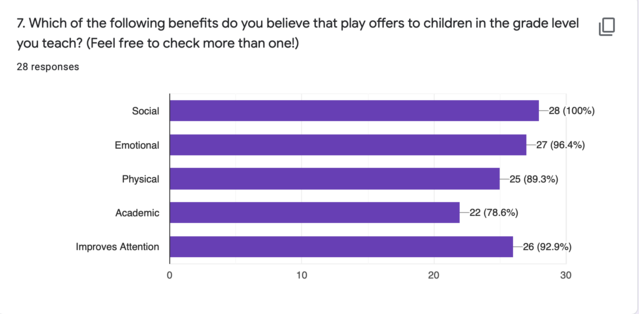Play
Play at School in a COVID-19 World
Why playing at school may be more important now than ever before.
Posted August 31, 2021 Reviewed by Vanessa Lancaster
Key points
- In a COVID-19 world, children's physical health and mental health are at risk.
- Researchers have found that play provides an array of benefits to children's physical and mental health.
- A survey of Pre-K through 3rd-grade teachers supports the need for incorporating play into children's daily education.
As children and teachers around the country begin a new school year and the COVID-19 pandemic continues to be a factor, children’s health is at the forefront of many minds. While, of course, their physical health is of concern, so is their mental health. I am a child psychologist who is particularly interested in the benefits of play.
Play has strong, positive impacts on children’s physical, mental, social, and even academic health. I, therefore, wanted to explore how educators view the role of play in children’s daily lives at school. If teachers agree that play offers so many benefits, then now–perhaps more than ever–it is crucial that play be a regular part of the school day.
Unfortunately, play in schools has decreased in recent years. Most studies, however, suggest that parents, principals, and teachers recognize that play is beneficial and that they wish kids had more time to play while at school.

To assess how teachers are feeling about play at school, I surveyed Pre-K through grade 3 teachers. I received responses from 27 teachers (2 Pre-K, 5 K, 9 1st grade, 3 2nd grade, 6 3rd grade, and 2 who did not specify their grade level). In response to the question, “Do you believe that play should be a part of students’ school day every day?”, 100% of respondents said “Yes.”

When asked to rate the importance of play to a student in their grade’s daily education on a scale of 1 to 6 (where 6 was very important), every teacher responded with a 4, 5, or 6, with the average rating being a 5.63. The rating of importance did not differ by grade level.
Teachers stated that, on average, they believed students should have 71.85 minutes of play per day while they were at school, not including gym class (the minimum response for this question was 30 minutes, and the maximum was 4 hours). This is notable when considered in conjunction with the results of a 2010 survey of 1951 schools showing that half of the schools reported having recess periods of only 30 minutes or less each day. It seems, then, that most teachers believe that their students need to have more play while at school than they are likely currently getting. Whether this means that schools need to lengthen recess periods or teachers need to incorporate more play into their instructional methods, play seems highly desirable to both students and their instructors.
Play should also be all-inclusive. On a scale of 1 to 6, where 6 indicated strong agreement, teachers rated their belief that children in their grade level with special needs should have play incorporated into their IEP’s at a 5.22. Children with disabilities who are taught to play show stronger social abilities later. When they are around typically developing children, they show more sophisticated play than when they are segregated. Therefore, it is important that educators recognize the importance of playing–and encouraging all of their students to play–with children of all ability levels.
I am also interested in the differences between structured and unstructured play. Should play at school be restricted to one or the other, or should both types be included? Structured play is playing with rules and set instructions. Examples include puzzles, board games, sports, Simon Says, etc. When asked what percentage of play in a child of their grade level’s school day they believed should be structured (excluding gym class), teachers responded with an average of 41.72%. Unstructured play is playing without rules or set instructions. Examples include pretend play, creative play, dress-up, miniature figures, dolls, action figures, etc. When asked what percentage of play in a child of their grade level’s school day they believed should be unstructured, teachers responded with an average of 38.46%. Teachers seem to agree that both types are necessary daily.

Interestingly, however, teachers were very much in favor of remaining primarily hands-off during their students’ play, at least during recess. When I asked them to rate the degree to which they feel that teachers should be involved in guiding their students’ play while they are at recess (where 1 = not at all involved and 6 = very involved), teachers answered with an average of 2.22.
So why do teachers believe that play is so important in children’s daily education? Research has demonstrated several benefits of play that are crucial to development. For example, Stegelin and colleagues noted that cognitively, play encourages children to learn, imagine, re-invent, categorize, and problem-solve. Play helps children to learn the skills necessary for learning to read, write, and do math. When I asked the teachers in my survey to rate their agreement (where 6 = strongly agree) with the statements that play can be used to enhance children’s literacy skills, mathematical skills, and science skills, teachers rated their agreement on average at 5.41, 5.41, and 5.48, respectively. Additionally, 78.6% of teachers stated that they believe that play offers academic benefits to children in the grade level that they teach.
Stegelin and colleagues also suggested that play provides children with a break to give the maximum attention to work when necessary. Similarly, 92.9% of the teachers surveyed here agreed that play helps to improve their students’ attention.
Many researchers have also discussed the social and emotional benefits of play. Play encourages cooperation, perspective-taking, communication, negotiation, turn-taking, conflict resolution, self-esteem, self-regulation, and emotional control. When I asked the teachers in my survey to rate their agreement (where 6 = strongly agree) with the statements that play can be used to enhance children’s conflict resolution, negotiation skills, and emotional regulation, teachers rated their agreement on average at 5.85, 5.76, and 5.74, respectively. Additionally, 100% of teachers stated that play offers social benefits to children in the grade level that they teach, and 96.4% also agreed that play offers emotional benefits.

Another benefit of play is, of course, that it encourages creativity. Hoffman, Russ, Mottweiler, and Taylor found correlations between the frequency of pretend play in children and their performances on measures of creativity and divergent thinking. Even longitudinal research (e.g., Mullineaux and Dilalla; Russ et al.) has found connections between levels of play in childhood and creativity in adolescence. When I asked the teachers in my survey to rate their agreement (where 6 = strongly agree) with the statement that play can enhance children’s creativity, teachers rated their agreement on average at 5.85.
Of course, I recognize that the survey results reported here are from just a small sampling of teachers. However, the responses to so many questions were so strong and consistent that I am confident the results would likely generalize to many teachers. In a COVID-19 world, when our students' physical and mental health has been endangered enough, let the children play! Play is important, it is beneficial, it is healthy, and it enhances education in multiple ways.




